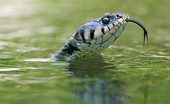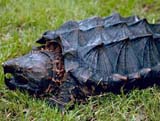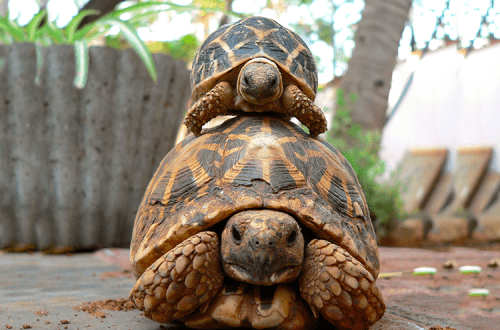
Grass Snake ordinary
This is a large snake, with an average body length of 80-90 cm, however, there are also individuals about one and a half meters in length. The upper body of the snake is olive, brown, black or gray, most often with black spots, which are sometimes staggered, as well as large orange spots that are located on the border of the neck on the sides of the head. Often there are individuals in which a mesh pattern is scattered over the entire surface of the body, which is formed by the dark and light edges of the scales. The ventral side of the body is blackish, white or gray.
The common snake is common in Europe, with the exception of the northern part of Great Britain, Ireland, and the northern part of Scandinavia. Of the nine subspecies, three subspecies are found on the territory of Russia. It lives most often along the banks of stagnant and flowing reservoirs, including sea coasts and rice fields. Dives and swims very well, snakes can often be found far out to sea. It can climb mountains up to 2000-2500 meters above sea level. As a shelter, he uses heaps of stones and brushwood, voids under the roots, holes of rodents. It can also be found in the vicinity of human habitation. The peak of activity of the common snake falls on the period from March to November. This snake feeds mainly on amphibians, as well as lizards and rarely fish. Small birds and mammals can also be eaten, and it doesn’t matter who becomes dinner for the snake. Whoever it is will be swallowed alive.
During the mating period, snakes form clusters of several dozen individuals. There are known cases of collective treasures, when there are few suitable places for laying eggs. One female lays an average of 4 to 40 elongated large eggs. The young are born in August-September.
Contents
Classification
Kingdom: Animals
Type. Chords
Subtype: Vertebrates
Class: Reptiles
Order: Scaly
Suborder: Snakes
Family: Already shaped
Genus: Grass Snakes
Style: Regular
Inhabitation
 The common snake is widely distributed throughout Europe, excluding Ireland, northern Great Britain, northwestern Africa, western Asia, northwestern Mongolia, southern Eastern Siberia and adjacent areas of northern China in the east and southwestern Iran in the south.
The common snake is widely distributed throughout Europe, excluding Ireland, northern Great Britain, northwestern Africa, western Asia, northwestern Mongolia, southern Eastern Siberia and adjacent areas of northern China in the east and southwestern Iran in the south.
It lives in fairly humid places. Most often, snakes can be found along the banks of calm rivers, lakes, ponds, grassy swamps, and in humid forests. Sometimes they can even crawl into the open steppe and mountains. Often, an ordinary grass snake can be found in barnyards, vegetable gardens and orchards. As a refuge, snakes use voids under the roots of trees, rocky embankments, rodent burrows, cracks in dams. In loose soil or fallen leaves, they can make their own moves. Snakes swim well, raising their heads above the surface of the water and leaving characteristic ripples behind them, so they can be easily seen while moving through the water. They can also be under water for several tens of minutes. This is a very mobile, active snake. She crawls fast, swims well and can climb trees. It can be found in the water for many kilometers from the coast. She swims, raising her head above the surface of the water and leaving a pronounced ripple behind her, so this snake will be easy to notice on the water.
Description
 Snakes are non-venomous snakes. The body length is 1-1 meters. The main difference between the snake and other snakes is the so-called “yellow ears” – pronounced marks on the head, most often yellow, but white or orange are also found. The color of the upper side of the body is gray, olive, black or brown. Often with dark (sometimes black) spots, which are sometimes staggered and narrow transverse stripes.
Snakes are non-venomous snakes. The body length is 1-1 meters. The main difference between the snake and other snakes is the so-called “yellow ears” – pronounced marks on the head, most often yellow, but white or orange are also found. The color of the upper side of the body is gray, olive, black or brown. Often with dark (sometimes black) spots, which are sometimes staggered and narrow transverse stripes.
The period of activity falls on the daylight hours, at night the snakes hide in shelters. They hunt mainly in the morning and evening hours. Snakes love to bask in the sun, choosing suitable places for this – stones, hummocks, tree branches hanging over the water, reed stalks. In the heat, they can sink to the bottom of reservoirs, where they cool for some time. Often, a characteristic mesh pattern is scattered over the entire surface of the body, which is formed by the light or dark edges of the body scales. The ventral side is white, gray or blackish. During periods of molting, snakes shed their old skin, crawling into narrow cracks. It is removed with a cover, starting from the head, like turning a glove inside out. 
With the onset of the cold period, it already falls into a stupor, having previously hidden in secluded places where the cold least penetrates, for example, in the voids between the roots of trees, cracks in the soil, deep holes of rodents. Sometimes snakes hibernate alone, but small collective winterings are not uncommon, and they will no longer avoid the neighborhood of representatives of other snake species. The common one leaves for wintering quite late – in October-November, when night frosts already come into force. Snakes begin to wake up from hibernation in March-April, becoming more and more active with each warm day.
Already non-aggressive. At the sight of a person, he flees. If you catch him, then at first he will actively defend himself: hisses, throws his head forward (this is intimidating for many enemies). If these actions do not cause the desired reaction, then another weapon can be used – smell. It is so disgusting and harsh that it discourages the appetite of four-legged predators. However, the smell is unstable and quickly disappears. Even if the smell does not work, then he can pretend to be dead.
The snakes have plenty of enemies: they are attacked by kites, snake-eagles, foxes, badgers, minks, raccoon dogs, martens. Egg laying and young individuals are often eaten by rats.
Food
The main diet of the common snake is amphibians and partly reptiles. They feed on frogs and toads, they can also feast on young lizards, small birds and their chicks, attacking nests nestled on the ground, and newborn cubs of water rats and muskrats can also become their victims. For one outing on the hunt, a large one can swallow up to 8 large tadpoles of a lake frog or frogs. Frogs pursued by snakes behave in a very peculiar way – they make rare and short jumps (although big jumps would bring salvation faster) and at the same time make a cry that is completely different from the sounds that we usually hear from them. It may rather resemble the bleating of a sheep. This persecution can hardly be called long, everything ends quickly enough. The snake eats the frog alive, and trying to start the meal from the head, most often they start swallowing the victim from the hind legs, gradually drawing the victim into the mouth. If at the time of dinner the snake is in danger, then most often he will burp the swallowed food. There were cases when he burped up live frogs, while they had just been in the throat of a snake, but, nevertheless, in their later life they turned out to be more than capable.
Young snakes often catch insects. These snakes drink a lot, especially on hot days. There is an opinion that snakes are very harmful to fish farming, as they feed on fish. Actually this is a misunderstanding. Small fish are eaten extremely rarely and in very small quantities.
Reproduction
 The mating season begins in April-May, after the period of the first spring molt ends. During this period, snakes form clusters of several dozen individuals. Female snakes begin to lay eggs in July-August, in humid and warm places. Heaps of humus, old straw, fallen leaves are ideal for this. Rotten stumps, damp moss, mouse holes will also do. At one time, the female lays up to 6 to 30 eggs. It is not uncommon for the eggs to stick together because of their softness and the parchment sheath they are covered with.
The mating season begins in April-May, after the period of the first spring molt ends. During this period, snakes form clusters of several dozen individuals. Female snakes begin to lay eggs in July-August, in humid and warm places. Heaps of humus, old straw, fallen leaves are ideal for this. Rotten stumps, damp moss, mouse holes will also do. At one time, the female lays up to 6 to 30 eggs. It is not uncommon for the eggs to stick together because of their softness and the parchment sheath they are covered with.
The embryos begin to develop already in the mother’s body, and in the newly laid eggs, one can notice the pulsation of the embryo’s heart. The snake lays its eggs in damp, but at the same time well-preserved places (about 25-30 degrees), since the eggs can quite easily die from drying out. For masonry, snakes most often choose damp moss, rotten stumps, fallen heaps of leaves, abandoned rodent burrows, and even sometimes garbage pits. It happens that due to the lack of good shelters for masonry, several females lay eggs in one place. Even in the body of the mother, the embryo goes through the initial stage of development, so you can easily notice the pulsation of the heart of the fetus in the eggs just laid by the snake. The incubation period lasts about 5-8 weeks. At the time of exit from the eggs, young snakes are about 15 cm long. They immediately sprawl and begin to lead an independent lifestyle.
Content
 Common snakes live well in captivity, quickly begin to take the food that is offered to them and quickly become completely tame. He needs a horizontal terrarium, spacious enough, with a large pond and several shelters. The minimum dimensions for one individual are 50*40*40 cm (excluding the height of the lamp). The soil is desirable hygroscopic – sphagnum moss, a mixture of gravel and earth. Lighting will need powerful. Daytime temperature 30-35 degrees, night about 21 degrees. In addition to temperature, humidity must also be maintained. To do this, the soil and moss must be sprayed regularly. They need water for drinking and bathing.
Common snakes live well in captivity, quickly begin to take the food that is offered to them and quickly become completely tame. He needs a horizontal terrarium, spacious enough, with a large pond and several shelters. The minimum dimensions for one individual are 50*40*40 cm (excluding the height of the lamp). The soil is desirable hygroscopic – sphagnum moss, a mixture of gravel and earth. Lighting will need powerful. Daytime temperature 30-35 degrees, night about 21 degrees. In addition to temperature, humidity must also be maintained. To do this, the soil and moss must be sprayed regularly. They need water for drinking and bathing.
In order to hibernate, at home you need to reduce daylight hours (gradually from 12 to 4 hours) and the heating period. You can keep snakes both alone and in small groups (2-3). In the terrarium, snakes are fed with toads, frogs and fish. The average life expectancy is about 20 years. Mandatory equipment that will be required to keep the snake: a lamp for irradiation, a lamp for lighting, a thermal cord or a thermal corvix, tweezers, a thermometer in a warm corner, a sprayer, a daytime thermostat, a water bowl. From additional equipment you can purchase: a night thermostat, a time relay, a thermometer in a cold corner.
Additionally
Among ordinary snakes, there are both melanistic individuals and almost complete albinos.
Collective clutches of common grass snakes are known. In such a place you can find up to 1200 eggs.
Like many snakes, snakes can go without food for a long time. A case is known when a snake starved for more than 300 days without harm to itself.
Other names
Natrix natrix Linnaeus, European grass snake, Ringed, Grass snake.
Subspecies
N. n. cetti – Sardinian grass snake, Zetta grass snake.
N. n. natrix is the nominative subspecies, Gewohnliche Ringelnatter.
N. n. corsa – Corsican grass snake.
N. n. scutata – common shield snake.
N. n. helvetica – Helvetian grass snake, Barren-Ringelnatter.
N. n. schweizeri – Schweizer’s common snake.
N. n. astreptophora – Pyrenean common snake, astreptophora – creeping (escaping) nose, escaping nose, carrying if it crawls (creeps).
N. n. sicula – common dagger snake.
N. n. persa – Persian common snake.





